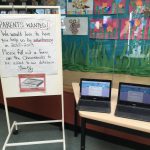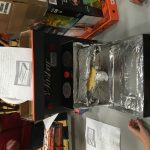We are a large school in a high-tech neighbourhood. Parents, administration, students and staff have demonstrated a strong interest in creating a Makerspace in our school. To date, it has been difficult to secure the time and resources required to make this vision a possibility. This grant would provide the necessary professional learning time to take on a project of this magnitude. Creating a Makerspace would unify our school community through achieving this common goal.
- Create a Makerspace in our school that all JDPS Dragons can access
- Promote creativity, innovation and critical thinking across the curriculum
- Encourage teachers to incorporate STEAM activities into their program/curriculum delivery
Team Members
Sarah Gaffney
Ottawa-Carleton District School Board
Karen Haanpaa
Ottawa-Carleton District School Board
David Hayward
Ottawa-Carleton District School Board
Lisa Lahey
Ottawa-Carleton District School Board
Andrew Hicks
Ottawa-Carleton District School Board
Professional Learning Goals
- Increased our knowledge/proficiency of 21st century skills (technology, coding, digital fluency, hands-on design tasks, creative problem-solving, robotics)
- Learned more about integrating STEAM activities across the curriculum
- Connected our staff across divisions and our curriculum across subjects
- Researched and understood the requirements and resources for a successful Makerspace
- Created a learning culture for teachers that pushes them and promotes encouraging student innovation and 21st century skills
Activities and Resources
Members attended MakerED night for teachers at Ottawa University’s Faculty of Engineering and learned about integration of technology across the curriculum (e.g., coding, 3D printing, Makerspace projects, circuits) and required elements of Makerspace (furniture, tools, gadgets/required materials). Our team also attended an incredible Makerspace workshop at another school where we learned about the creation and utilization of their Makerspace. We were linked via video chat to three other sites and their spaces. It was a great way to gather information about resources, furniture, scheduling, programming, successes, must-haves, road blocks, funding and community involvement.
We were able to secure our board technology coach for two of our release days. He toured our school and brought with him a wealth of knowledge surrounding the maker movement and STEAM learning. He provided advice based on what has been successful in other sites. He worked closely with our team and recommended the best physical use of space, furniture, tools, storage and scheduling. We took staff questions and concerns (gathered through staff and division meetings) into consideration as we planned for the space, looked into ordering resources and furniture. Our team brainstormed, researched and decided upon a plan of action to unite our school through the maker culture for Education Week. The “not-a-pizza box” cardboard challenge was born!
Our project team planned and prepared for the school-wide cardboard challenge (cardboard fasteners, schedules, outlines, success criteria, cross-division class pairings, teacher instructions, parent invitations, ordered supplies for the challenge, created Google Forms for visiting parents to complete and created a volunteer/community expertise database for next year, collected pizza boxes from neighbouring schools, unpacked and distributed materials and supplies for the cardboard challenge, and created signs to share plans/vision for the STEAM lab).
Education Week: #notapizzabox Cardboard Challenge-class pairings met once a day Monday to Thursday to plan, design and build their cardboard creations. Project teams took pics of the learning, leadership and team building in each class. Collated pics into slideshow that was displayed during the Maker Fair. Friday: 700 students and their cardboard projects in the gym! Parents invited to circulate along with students to view the creations.
Our final team meeting involved taking measurements for shelving and furniture and researching prices and approved vendors. We created a master list of resources for Makerspace sorted by area of need (furniture, storage, electronics, lighting, media, books, consumables, recycled materials) that was shared with our principal. This list will be presented to the parent council in June.
Unexpected Challenges
- Our most tech-savvy team member was hired in February to work in another board. Luckily, we found another eager primary teacher to take her place and complete our cross-divisional team.
- Our project leader incurred a concussion at school and was not able to work during the month of January and is still on a very reduced work schedule. This made for some delays in getting our project rolling, but allowed for very focused work when we were together.
- A LOT of resistance and apprehension from several teachers regarding the usefulness and purpose behind the Education Week cardboard challenge and the usefulness of a Makerspace. There were concerns over wasted time, purpose, pairing of students across divisions, reactions of certain students with this break from structure, scheduling, prep time and direction.
- Patience and staying strong was key for our team in not succumbing to the negativity and push-back we were experiencing from some colleagues. We continued to direct staff to the detailed plans, models and success criteria laid out for them by our team and reassured them that it was going to be a rich learning experience for all students and staff.
- Some materials (cardboard saws) were put on back order and did not arrive in time for the challenge. Class pairings were understanding and shared resources accordingly. Project team went shopping and found alternate solutions.
- Ordering furniture through the school board is a long and slow process. We are happy to have started this in plenty of time to have things in place for the fall.
Enhancing Student Learning and Development
Enhanced student learning (cardboard design challenge)
- Cross-division age pairings (e.g., Grade 6 with Grade 1) required students to collaborate on a new level and develop listening and leadership skills
- The design challenge gave an open-ended opportunity for planning, taking creative risks, thinking “outside the pizza box” and overcoming challenges (personalities, behaviour, construction/design problems)
- Teams had to share their thinking and collective experience on a reflection page that was posted with their project in the gym
- Team members had to orally communicate with parents, teachers and peers at the Cardboard Challenge Maker Fair
Could enhance student learning (Dragon STEAM Lab 2018/2019)
- A collaborative and engaging learning space that allows students to deepen their learning in a hands-on environment
- Students can experience an immediate sense of ownership and pride of their work through the problem-solving and risk-taking process
- Enhances curriculum by aligning what students have learned with what they are creating (personal/world connections)
- Students are encouraged to wonder, imagine and innovate
Sharing
- Project team members presented at staff meetings and division team meetings, and took note of questions and concerns at their respective team meetings. Principal shared progress and plans from the team regarding the Makerspace project at parent council meetings.
- Principal used our school Twitter @JackDPS account to remind families of the school-wide event and share the success of the big day! Our tech coach and board retweeted the info/pics. Our principal plans on continuing to promote our space through the school Twitter account, as we move forward.
- We shared our progress and learning with colleagues from other schools at the Makerspace workshop we attended
- We plan on inviting our feeder schools to the Dragon STEAM Lab, once it is complete
- Our board tech coach will be helping us share our journey with the rest of the board, through his work on collecting data and experiences from different sites
Project Evaluation
Maker Fair in May during Education Week to celebrate and share our school-wide STEAM learning with the community. Parent, administration, staff and student feedback was overwhelmingly positive. Students and parents were very quick to ask about plans for next year. Numerous parents completed our Google Form for our community volunteers/experts database.
We are a huge school. Planning, scheduling and co-ordinating for all Grade 1-8 students and staff was a massive undertaking. We were very proud of the effective use of our beloved release time (multi-tasking for the Maker Fair and the creation of the Makerspace).
Teachers in each division will have increased confidence/proficiency using STEAM/Maker activities and will have completed a Maker-based project with their students. After the challenge was complete, staff were quick to admit that this design project helped them overcome their own insecurities and apprehensions regarding this type of open-ended STEAM task. Quite a few needed reassurance that the students would do well, if given the chance to guide their own inquiry and design. Some teachers had reservations regarding specific students’ ability to cope with this unstructured/student-led learning activity. They were pleasantly surprised by the engagement and perseverance displayed by all students.
Successful creation of the Makerspace. Laying the groundwork, planning the space and creating a Maker culture was our major goal this year, so that the Dragon STEAM Lab could be a reality next year. We have secured the classroom that will house the STEAM Lab, have ordered preliminary furniture and have compiled a detailed list of “must-haves” and future “wanted items” that our administration has been, and will be, reviewing with our parent council. They were very eager to help and approved our preliminary order for the Education Week cardboard challenge supplies. Our administrative team has also been very supportive of this endeavour and continuing to support us as we move forward with the development of the physical space. We are proud of the positive buzz that has been created in our learning community.
Resources Used
The Kickstart Guide to Making Great Makerspaces by Laura Fleming. This was a great resource for all things to consider in the planning and implementing our Makerspace.
https://www.amazon.ca/Kickstart-Guide-Making-Great-Makerspaces/dp/1506392520
Awesome site for learning and planning a Makerspace
http://www.makereducation.com/maker-education-starter-guides.html
Coding ideas and resources. Very easy to implement. Many of our classes participated in the Hour of Code in December.
Ideas for projects
The inspiration for our #notapizzabox challenge. Not a Box by Antoinette Portis was the read-aloud book to kick off our school challenge.
Resources Created
These resources will open in your browser in a new tab, or be downloaded to your computer.






